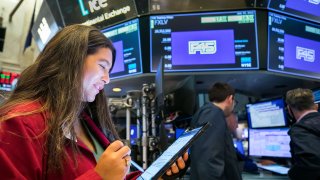
The 10-year Treasury yield rose as high as 1.75% on Thursday, as the rate spike in the new year resumed with investors assessing the Federal Reserve's faster-than-expected policy tightening.
The yield on the benchmark 10-year Treasury note came slightly off its high and was last up by 2 basis points to 1.725%, rising for a fourth straight day. The benchmark rate ended 2021 at 1.51%.
The yield on the 30-year Treasury bond moved less than 1 basis point higher to 2.024%. Yields move inversely to prices and 1 basis point is equal to 0.01%.
The minutes from the Federal Reserve's December policy meeting, released Wednesday, showed that the central bank had begun plans to start reducing the number of bonds it holds.
Get Connecticut local news, weather forecasts and entertainment stories to your inbox. Sign up for NBC Connecticut newsletters.
Fed officials said the reduction in its balance sheet would likely start sometime after the central bank begins raising interest rates.
"One aspect of the selloff which speaks to the sustainability of the progress toward higher yields is that the move has been in real rates," Ian Lyngen, BMO's head of U.S. rates, said in a note. "This is consistent with the FOMC Minutes reinforcing the Committee's hawkishness and reflects investors' renewed faith in the Fed's ability and willingness to combat the amount of inflation presently in the system."
Initial claims for unemployment insurance ticked up to 207,000 for the week ending Jan.1, the Labor Department reported Thursday. Economists surveyed by Dow Jones expect claims would total 195,000.
Money Report
This comes after ADP's employment change report, released Wednesday, showed that 807,000 private payrolls were added in December, well above an estimate of 375,000 jobs.
Investors will now be looking ahead to the closely watched December nonfarm payrolls report, due out on Friday morning.
Brian Nick, chief investment strategist at Nuveen, told CNBC's "Squawk Box Europe" on Thursday that he believed that Friday's nonfarm payrolls report could be "quite strong."
However, he suggested that the effects of the omicron variant on the labor market would likely be seen only in the January report, which is due for release in early February.
Nick said a weaker nonfarm payrolls report next month could put the Fed in an "awkward position" in terms of raising interest rates "much sooner than expected just a few months ago."
Market expectations are for the Fed to start raising its benchmark interest rate in March. Fed officials have indicated that they foresee as many as three rate hikes in 2022.
Auctions are scheduled to be held on Thursday for $50 billion of 4-week bills and $40 billion of 8-week bills.
— CNBC's Jeff Cox contributed to this market report.






